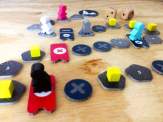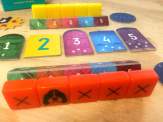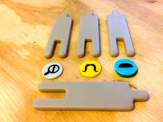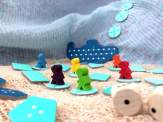| Release Date: 2011 | Players: 5-10 |
| Designer: Jun Sasaki | Length: 15-60 minutes |
| Artist: Jun Sasaki | Age: 8+ |
| Publisher: Oink Games | Complexity: 1.0 / 5 |
| Plastic (by weight): 20% | Air (by volume): <25% |
The gallery was packed. People were chatting, holding glasses of champagne or plates with little aperitifs. Some of the attendees agitatedly pointed at artworks, clearly moved by what they were seeing. The gallerist had picked the artists and their artwork according to a common theme. Everything worked harmoniously together, except maybe one or two pieces, which were slightly at odds with everything else on display. They seemed a bit vague. It was as if, among the list of creators in the exhibition, there was A Fake Artist Goes to New York by Jun Sasaki from Oink Games.
I think you get a hint of what this game is about from the introduction. Among the players is one person who has no idea what it is that everyone is meant to draw. However, they are doing their best to stay hidden. So while all the other players have in front of them the word that they’re supposed to draw, one person’s prompt sheet is blank. Yet, nobody knows who is clueless and just blagging their way through the game, except the fake artist themselves.
Pretend, Lie and Fabricate
A Fake Artist Goes to New York is a wonderful social deduction game that can be played for points or just to have fun. One person is in charge of choosing a general topic, which they publicly announce and then secretly choosing a word from that topic that everyone will have to draw. So the topic might be “sky” and the word “cloud”. The player writes the word onto little dry-erase tiles, one for each artist, except one, who will just have a cross on theirs. The tiles are shuffled (make sure you let the marker dry sufficiently first) and randomly handed out to players face down. Everyone secretly looks at their tile, which is when one player will know it’s them who is the fake artist.
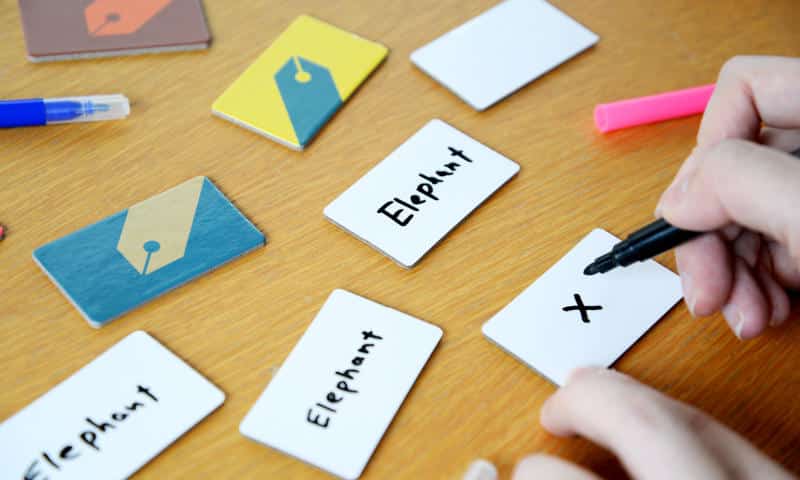
Once everyone is happy, players take turns drawing a single line on a notepad. Everyone’s pen has a different colour, so everyone knows who drew what. The line can be as long or as short as you want. It can cross itself or go across other lines. It doesn’t really matter. The only requirement is that the pen doesn’t leave paper. Once the pen is lifted off, the player’s turn is over.
The real artists want to draw just enough to show their team that they know what the word is. However, they don’t want to draw too much, because otherwise, the fake artist would be able to guess the word that everyone already knows. The fake artist will do their best to appear as if they know exactly what it is that everyone is drawing. Yet, they will most likely be rather non-commital, maybe drawing a very short line or copying something someone else drew. Of course, they will claim they know exactly what they’re doing.
Accusations and Finger Pointing
While all of this goes on, there will be a lot of table talk. Players will accuse each other of being the fake artist. They will point out how another player’s line doesn’t make any sense and that, clearly, they must be the fake. So if the real fake artist can sow enough suspicion, chances are that other players will believe them and start to mistrust the real artists on their team.

Get yourself a wooden Tabletop Games Blog dice tray.
Each tray is the perfect size to roll your dice, and with the soft mat, it’s really quiet, while the wooden frame makes it wonderfully sturdy.
Once everyone has drawn two lines, it’s time to choose who they think the fake artist is. The player who chose the word will do a countdown after which everyone needs to point at another player. Now the fake artist reveals themselves. If they had the most fingers pointed at them, they risk losing the round. However, they can redeem themselves if they successfully name the word that everyone was trying to draw. If they get it right, they win. Alternatively, if most fingers were pointed at a player who wasn’t the fake artist, the fake wins. So there are plenty of chances for the fake artist to win, but playing against a group deserves a little advantage.
If the fake artist does win, then the player who chose the topic and word wins along with them. That’s actually quite an important point. It’s not really the fake artist playing by themselves. The person choosing a topic and word probably wants to select something that is quite easy to draw and obvious. If they can find a word that makes it hard for the real artists to disguise what it is they’re drawing, the fake artist gets another little advantage. It’s a nice way of involving the player who basically sits out the round and watches everyone else draw.
Go Again
Now you can award points and go again, choosing a different player as the person who chooses the topic and word. Or you can just ignore the points. A Fake Artist Goes to New York is the sort of game where points aren’t important. In fact, it’s better without scores. It allows you to have different people play every round. While someone makes cups of tea, someone else joins in. If you play with younger children, they can play one round, then leave and join in again later. What really makes the game fun is the table talk, the accusations and the desperate justifications for why someone drew a line the way they did.
I’m not usually someone who likes social deduction or hidden traitor games, but because the fake artist stays hidden right until the end, you don’t feel quite so exposed. You can really lean into the role of the fake artist and start accusing everyone else of drawing weird lines. Or you can just sit back and watch what everyone else is doing and hope you can glean some clues. You’re in a sort of safe space.
As a social deduction game, A Fake Artist Goes to New York does require quite a lot of players. That’s unavoidable and made it quite hard for me to get it to the table. However, it’s perfect for family gatherings or playing down the pub with your friends. It comes in a small box, making it easy to take with you and doesn’t take long to explain. It also plays really quickly. So if someone is really uncomfortable being the fake artist, they won’t suffer long. It really is a great party game and I highly recommend you give it a go.
If you enjoyed this article, please have a look at my support page to see how you can help keep the blog going.
Useful Links
- A Fake Artist Goes to New York: https://oinkgames.
com/ en/ games/ analog/ a-fake-artist-goes-to-new-york/ - Rulebook: https://boardgamegeek.
com/ filepage/ 91071/ english-rules-oink-games - Oink Games: https://oinkgames.
com/ en/ - BGG listing: https://boardgamegeek.
com/ boardgame/ 135779/ fake-artist-goes-new-york
Videos
Transparency Facts
I feel that this review reflects my own, independent and honest opinion, but the facts below allow you to decide whether you think that I was influenced in any way. Please also read my Ethics Statement for more information.- I bought and paid for the game myself.
- At the time of writing, I have not received financial support from the publisher or anyone working on their behalf.
Audio Version
Intro Music: Bomber (Sting) by Riot (https://www.
Sound Effects: bbc.co.uk – © copyright 2023 BBC
The following music was used for this media project:
Music: Afternoon by DreamHeaven
Free download: https://filmmusic.io/song/6242-afternoon
License (CC BY 4.0): https://filmmusic.io/standard-license
Artist website: https://www.patreon.com/dreamheaven


